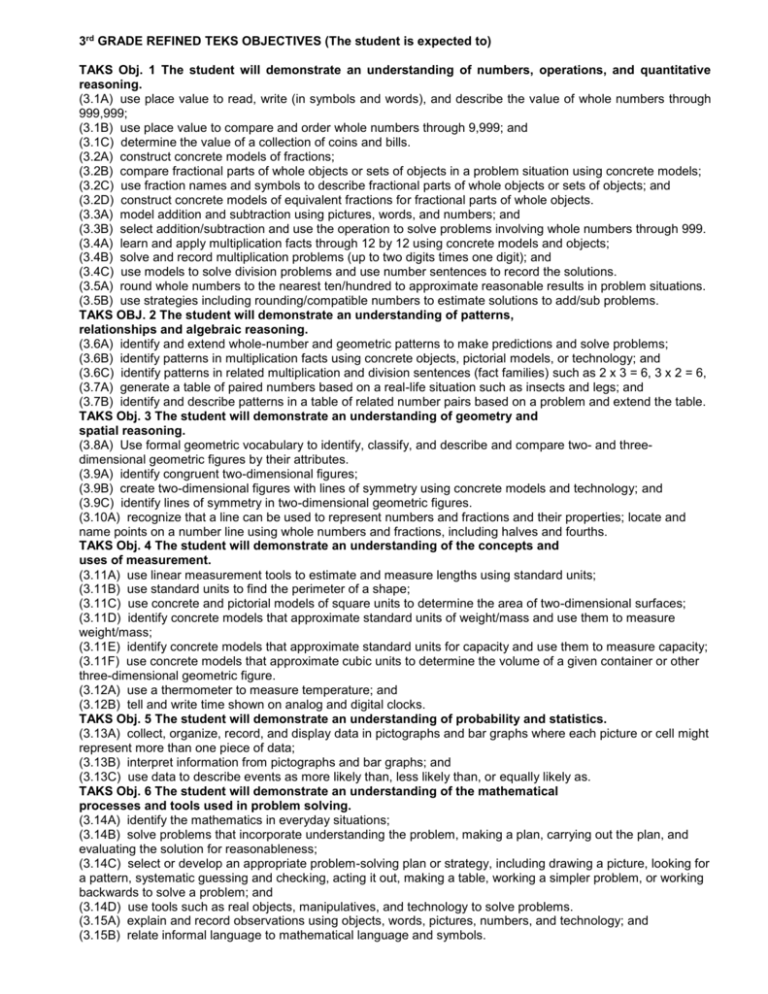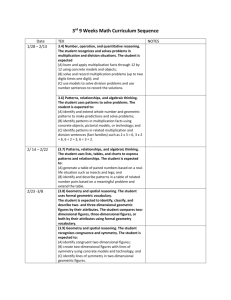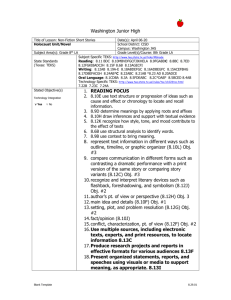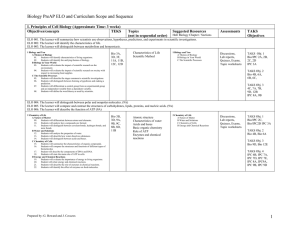3rd GRADE TEKS BOJECTIVES (The student is expected to)
advertisement

3rd GRADE REFINED TEKS OBJECTIVES (The student is expected to) TAKS Obj. 1 The student will demonstrate an understanding of numbers, operations, and quantitative reasoning. (3.1A) use place value to read, write (in symbols and words), and describe the value of whole numbers through 999,999; (3.1B) use place value to compare and order whole numbers through 9,999; and (3.1C) determine the value of a collection of coins and bills. (3.2A) construct concrete models of fractions; (3.2B) compare fractional parts of whole objects or sets of objects in a problem situation using concrete models; (3.2C) use fraction names and symbols to describe fractional parts of whole objects or sets of objects; and (3.2D) construct concrete models of equivalent fractions for fractional parts of whole objects. (3.3A) model addition and subtraction using pictures, words, and numbers; and (3.3B) select addition/subtraction and use the operation to solve problems involving whole numbers through 999. (3.4A) learn and apply multiplication facts through 12 by 12 using concrete models and objects; (3.4B) solve and record multiplication problems (up to two digits times one digit); and (3.4C) use models to solve division problems and use number sentences to record the solutions. (3.5A) round whole numbers to the nearest ten/hundred to approximate reasonable results in problem situations. (3.5B) use strategies including rounding/compatible numbers to estimate solutions to add/sub problems. TAKS OBJ. 2 The student will demonstrate an understanding of patterns, relationships and algebraic reasoning. (3.6A) identify and extend whole-number and geometric patterns to make predictions and solve problems; (3.6B) identify patterns in multiplication facts using concrete objects, pictorial models, or technology; and (3.6C) identify patterns in related multiplication and division sentences (fact families) such as 2 x 3 = 6, 3 x 2 = 6, (3.7A) generate a table of paired numbers based on a real-life situation such as insects and legs; and (3.7B) identify and describe patterns in a table of related number pairs based on a problem and extend the table. TAKS Obj. 3 The student will demonstrate an understanding of geometry and spatial reasoning. (3.8A) Use formal geometric vocabulary to identify, classify, and describe and compare two- and threedimensional geometric figures by their attributes. (3.9A) identify congruent two-dimensional figures; (3.9B) create two-dimensional figures with lines of symmetry using concrete models and technology; and (3.9C) identify lines of symmetry in two-dimensional geometric figures. (3.10A) recognize that a line can be used to represent numbers and fractions and their properties; locate and name points on a number line using whole numbers and fractions, including halves and fourths. TAKS Obj. 4 The student will demonstrate an understanding of the concepts and uses of measurement. (3.11A) use linear measurement tools to estimate and measure lengths using standard units; (3.11B) use standard units to find the perimeter of a shape; (3.11C) use concrete and pictorial models of square units to determine the area of two-dimensional surfaces; (3.11D) identify concrete models that approximate standard units of weight/mass and use them to measure weight/mass; (3.11E) identify concrete models that approximate standard units for capacity and use them to measure capacity; (3.11F) use concrete models that approximate cubic units to determine the volume of a given container or other three-dimensional geometric figure. (3.12A) use a thermometer to measure temperature; and (3.12B) tell and write time shown on analog and digital clocks. TAKS Obj. 5 The student will demonstrate an understanding of probability and statistics. (3.13A) collect, organize, record, and display data in pictographs and bar graphs where each picture or cell might represent more than one piece of data; (3.13B) interpret information from pictographs and bar graphs; and (3.13C) use data to describe events as more likely than, less likely than, or equally likely as. TAKS Obj. 6 The student will demonstrate an understanding of the mathematical processes and tools used in problem solving. (3.14A) identify the mathematics in everyday situations; (3.14B) solve problems that incorporate understanding the problem, making a plan, carrying out the plan, and evaluating the solution for reasonableness; (3.14C) select or develop an appropriate problem-solving plan or strategy, including drawing a picture, looking for a pattern, systematic guessing and checking, acting it out, making a table, working a simpler problem, or working backwards to solve a problem; and (3.14D) use tools such as real objects, manipulatives, and technology to solve problems. (3.15A) explain and record observations using objects, words, pictures, numbers, and technology; and (3.15B) relate informal language to mathematical language and symbols.








